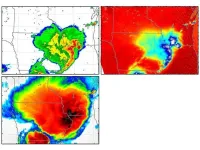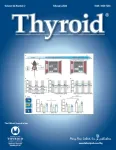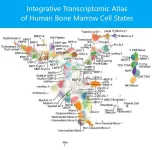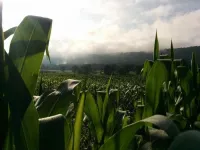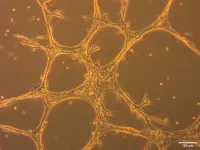(Press-News.org) UNIVERSITY PARK, Pa. — In 2020, a line of severe thunderstorms unleashed powerful winds that caused billions in damages across the Midwest United States. A technique developed by Penn State scientists that incorporates satellite data could improve forecasts — including where the most powerful winds will occur — for similar severe weather events.
The researchers reported in the journal Geophysical Research Letters that adding microwave data collected by low-Earth-orbiting satellites to existing computer weather forecast models produced more accurate forecasts of surface gusts in a case study of the 2020 Midwest Derecho. Derechos are lines of intense thunderstorms notorious for their damaging winds.
“The computer model is able to produce a series of forecasts that consistently emphasize the most powerful storms and strongest wind damage at where it happened,” said Yunji Zhang, assistant professor in the Department of Meteorology and Atmospheric Science at Penn State and lead author. “If we have this kind of information in real time, before the events occur, forecasters might be able to pinpoint where the strongest damage is going to happen.”
The technique could be especially useful, the scientists said, in areas that lack ground-based weather monitoring infrastructure — like radars traditionally used in weather forecasting. In the study, the researchers only used data available from satellite observations.
“In regions where there are no surface observations, or basically no radar, we show that this combination of satellite observations can generate a decent forecast of severe weather events,” Zhang said. “We can probably apply this technique to more regions where there are no radar or dense surface observations. That’s the fundamental motivation behind this study.”
The research builds on the team’s prior work using data assimilation, a statistical method that aims to paint the most accurate picture of current weather conditions. This includes even small changes in the atmosphere as they can lead to large discrepancies in forecasts over time.
In prior work, scientists with Penn State’s Center for Advanced Data Assimilation and Predictability Techniques assimilated infrared brightness temperature data from the U.S. Geostationary Operational Environmental Satellite, GOES-16. Brightness temperatures show how much radiation is emitted by objects on Earth and in the atmosphere, and the scientists used infrared brightness temperatures at different frequencies to paint a better picture of atmospheric water vapor and cloud formation.
But infrared sensors only capture what is happening at the cloud tops.
Microwave sensors view an entire vertical column, offering new insight into what is happening underneath clouds after storms have formed, the scientists said.
“Just based on the cloud tops, it’s more difficult to infer what the convection of these storms looks like underneath,” Zhang said. “So that’s one of the benefits of adding in the microwave observations — they can provide information on where the strongest convections are.”
By combining assimilated infrared and microwave data in the study of the derecho, the researchers were able to predict surface gust locations and maximum wind values more accurately.
In future work, Zhang said he plans to apply the method to regions that lack the resources and infrastructure to support high-spatiotemporal-resolution weather observations.
“We know that there have been several times in the past several years in West Africa where very strong torrential rainfall events have brought on a lot of precipitation to those countries,” Zhang said. “And one thing about these countries is that they are also the places that will likely be impacted most by global warming. So I think if we can use these available satellite observations to provide better forecast for those regions, it will be really beneficial for the people there as well.”
Also contributing from Penn State were David Stensrud and Eugene Clothiaux, professors, and Xingchao Chen, assistant professor, all in the Department of Meteorology and Atmospheric Science.
NASA and the U.S. Department of Energy provided funding for this work.
END
Satellite data assimilation improves forecasts of severe weather
2024-03-21
ELSE PRESS RELEASES FROM THIS DATE:
Morality among low-risk differentiated thyroid cancer survivors in the U.S.
2024-03-21
A new study has shown that overall and cause-specific mortality rates in individuals in the U.S. with low-risk differentiated thyroid cancer (DTC) are low. The study is published in the peer-reviewed journal Thyroid®, the official journal of the American Thyroid Association® (ATA®). Click here to read the article now.
Cari Kitahara, PhD, from the National Cancer Institute, National Institutes of Health, and coauthors identified 51,854 individuals diagnosed with first primary DTC at low risk ...
Most detailed atlas to date of human blood stem cells could guide future leukemia care
2024-03-21
Thanks to an unusual application of game theory and machine learning technology, a large team of scientists led by experts at Cincinnati Children’s has published the world’s most detailed “atlas” of the many types of stem cells and early progenitors involved in producing human blood from diverse donors.
The team has identified more than 80 distinct subsets of hematopoietic stem and progenitor cells (HSPCs) – early-stage cells that kick off production of mature red cells, white cells ...
Novel method to measure root depth may lead to more resilient crops
2024-03-21
UNIVERSITY PARK, Pa. — As climate change worsens global drought conditions, hindering crop production, the search for ways to capture and store atmospheric carbon causing the phenomenon has intensified. Penn State researchers have developed a new high-tech tool that could spur changes in how crops withstand drought, acquire nitrogen and store carbon deeper in soil.
In findings published in the January issue of Crop Science, they describe a process in which the depth of plant roots can be accurately estimated by scanning leaves with ...
Scientists develop catalyst designed to make ammonia production more sustainable
2024-03-21
Ammonia is one of the most widely produced chemicals in the world, and is used in a great many manufacturing and service industries. The conventional production technology is the Haber-Bosch process, which combines nitrogen gas (N2) and hydrogen gas (H2) in a reactor in the presence of a catalyst. This process requires high levels of temperature and pressure, resulting in substantial power consumption. Indeed, ammonia production is estimated to consume 1%-2% of the world’s electricity and to account for about 3% of global carbon emissions.
In pursuit of more sustainable alternatives, researchers affiliated with the Center for Development of Functional Materials (CDMF) ...
Forest, stream habitats keep energy exchanges in balance, global team finds
2024-03-21
UNIVERSITY PARK, Pa. — Forests and streams are separate but linked ecosystems, existing side by side, with energy and nutrients crossing their porous borders and flowing back and forth between them. For example, leaves fall from trees, enter streams, decay and feed aquatic insects. Those insects emerge from the waters and are eaten by birds and bats. An international team led by Penn State researchers has now found that these ecosystems appear to keep the energy exchanges in balance — a finding that the scientists called surprising.
Scientists ...
Product that kills agricultural pests also deadly to native Pacific Northwest snail
2024-03-21
CORVALLIS, Ore. – A product used to control pest slugs on farms in multiple countries is deadly to least one type of native woodland snail endemic to the Pacific Northwest, according to scientists who say more study is needed before the product gains approval in the United States.
Dee Denver of the Oregon State University College of Science led a 10-week laboratory project that showed the effect of a biotool marketed as Nemaslug on the Pacific sideband snail. The study was published today in PLOS One.
Nemaslug is based on the organism Phasmarhabditis hermaphrodita, a species of tiny, parasitic worm known as a nematode.
The ...
Two keys needed to crack three locks for better engineered blood vessels
2024-03-21
UNIVERSITY PARK, Pa. — Blood vessels engineered from stem cells could help solve several research and clinical problems, from potentially providing a more comprehensive platform to screen if drug candidates can cross from the blood stream into the brain to developing lab-grown vascular tissue to support heart transplants, according to Penn State researchers. Led by Xiaojun “Lance” Lian, associate professor of biomedical engineering and of biology, the team discovered the specific molecular signals that can efficiently mature nascent stem cells into the endothelial cells that comprise the vessels and regulate exchanges to and ...
UTEP faculty launch research lab to support human performance
2024-03-21
EL PASO, Texas (Mar. 21, 2024) - Professors at The University of Texas at El Paso have launched a new industrial engineering lab focused on supporting human performance and behavior in various application areas. Projects include supportive exoskeletons for high-strain occupations and virtual reality that simulates high-stress environments.
The facility, known as the Physical, Information and Cognitive Human Factors Engineering (PIC-HFE) Research Lab, was established with the help of a $350,000 STAR grant from the State of Texas.
The lab is led by Priyadarshini Pennathur, Ph.D., and Arunkumar ...
Improving & maintaining heart health after pregnancy may reduce the risk of future CVD
2024-03-21
Research Highlights:
An analysis of health records for almost 110,000 women in the U.K. found that women with poor cardiovascular health after pregnancy or who experienced adverse pregnancy outcomes, including high blood pressure, gestational diabetes and/or pre-term birth, had a significantly higher long-term risk of developing cardiovascular disease.
Among women with adverse pregnancy outcomes, those who maintained better cardiovascular health after pregnancy had cardiovascular disease risk similar to women who had no history of pregnancy complications.
Embargoed until 1:30 p.m. CT/2:30 ...
New generation estrogen receptor-targeted agents in breast cancer
2024-03-21
https://www.scienceopen.com/hosted-document?doi=10.15212/AMM-2024-0006
Announcing a new publication for Acta Materia Medica journal. Endocrine therapy that blocks estrogen receptor signaling has been effective for decades as a primary treatment choice for breast cancer patients expressing the estrogen receptor. However, the issue of drug resistance poses a significant clinical challenge. It is therefore critically important to create new therapeutic agents that can suppress ERα activity, particularly in cases of ESR1 mutations. This review article highlights recent efforts in drug development of next ...
